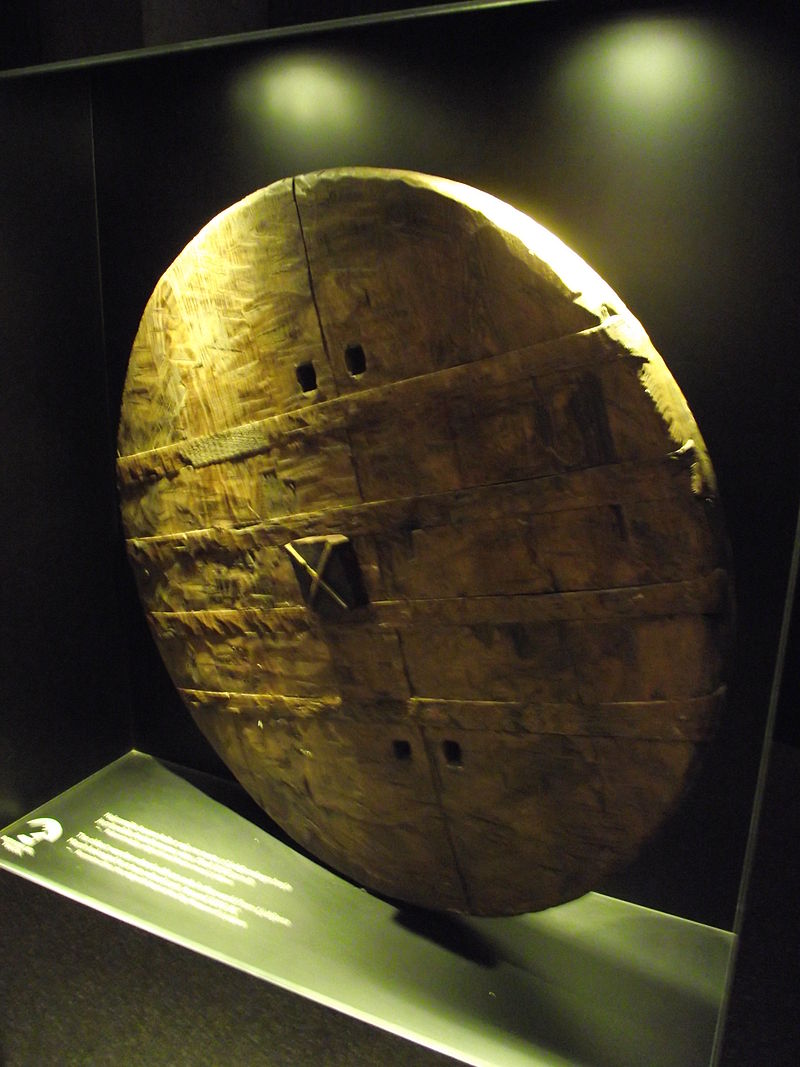Ljubljana Marshes Wheel (Koło z bagien Lubljańskich)
The Ljubljana Marshes Wheel is a wooden wheel that was found in the Ljubljana Marshes some 20 kilometres (12 mi) south of Ljubljana, the capital of Slovenia, in 2002.[1] Radiocarbon dating, performed in the VERA laboratory (Vienna Environmental Research Accelerator) in Vienna, showed that it is approximately 5,150 years old, which makes it the oldest wooden wheel yet discovered. It was discovered by a team of Slovene archeologists from the Ljubljana Institute of Archaeology, a part of the Research Center at the Slovene Academy of Arts and Sciences, under the guidance of Anton Velušček.
The archaeological site
Remains of pile dwellings were discovered in the Ljubljana Marshes as early as in 1875. Since 2011, the site has been protected as a UNESCO World Heritage Site as an example of prehistoric pile dwellings around the Alps, a special form of dwellings in areas with lakes and marshes. The archaeologists at the excavation site identified over one thousand piles in the bed of the Iška River, near Ig. They reconstructed the dwellings of 3.5 by 7 metres (11 ft × 23 ft) in size, separated by approximately 2 to 3 metres (6 ft 7 in to 9 ft 10 in). The analyses of the piles revealed that the dwellings were repaired each year and that a new house had to be built on the same place in as little as 10 to 20 years.
The oldest inhabitants settled in the region as early as 9,000 years ago; in the Mesolithic they built temporary residences on isolated rocks in the marsh and on the fringe and they lived by hunting and gathering. The permanent settlements were not built until the first farmers appeared approximately 6,000 years ago in the time of the Neolithic.
The wooden wheel
The wooden wheel belonged to a prehistoric two-wheel cart – a pushcart. Similar wheels have been found in the hilly regions of Switzerland and southwest Germany, but the Ljubljana Marshes one is bigger and older. It shows that wooden wheels appeared almost simultaneously in Mesopotamia and Europe.[1]
It has a radius of 72 centimetres (28 in) and is made of ash wood, and its 124-centimetre-long (49 in) axle is made of oak. The axle was attached to the wheels with oak wood wedges, which meant that the axle rotated together with the wheels. The wheel was made from a tree that grew in the vicinity of the pile dwellings and at the time of the wheel construction was approximately 80 years old.
References
- Gasser, Aleksander (March 2003). „World’s Oldest Wheel Found in Slovenia”. Government Communication Office of the Republic of Slovenia.
Further reading
- Velušček, Anton (ed.) (2009). Stare Gmajne Pile-Dwelling Settlement and its Era (bilingual English and Slovenian edition). Založba ZRC. ISBN 978-961-254-155-2.
©Tłumaczenie Czesław Białczyński
Koło z bagien lubljańskich
To drewniane koło, zostało znalezione na bagnach w odległości około 20 km (12 mil) na południe od Lublany, stolicy Słowenii, w 2002 r. [1]
Datowanie radiowęglowe, przeprowadzone w laboratorium VERA (Vienna Environmental Research Accelerator) w Wiedniu, wykazało, że ma ono około 5 150 lat, co czyni go najstarszym odkrytym drewnianym kołem. Zostało odkryte przez zespół słoweńskich archeologów z Instytutu Archeologii w Ljubljanie, będącego częścią Centrum Badawczego Słoweńskiej Akademii Sztuki i Nauki, pod kierunkiem Antona Veluščka.
Stanowisko archeologiczne
Pozostałości domów palowych odkryto na bagnach w Ljubljanie już w 1875 r. Od 2011 r. Obiekt został objęty ochroną jako miejsce wpisane na listę światowego dziedzictwa UNESCO jako przykład prehistorycznych domów palowych w Alpach, szczególnej formy zabudowań mieszkalnych na obszarach z jeziorami i bagnami. Archeolodzy w miejscu wykopalisk zidentyfikowali ponad tysiąc pali w łożu rzeki Iška, w pobliżu Ig. Odtworzono domostwa o wymiarach 3,5 na 7 metrów (11 stóp × 23 stóp), rozdzielone przez około 2 do 3 metrów (6 stóp 7 cali do 9 stóp 10 cali). Analizy pali ujawniły, że mieszkania były naprawiane każdego roku i że w ciągu zaledwie 10 do 20 lat budowano praktycznie w tym samym miejscu nowy dom.
Najstarsi mieszkańcy osiedlili się w regionie już 9000 lat temu; w mezolicie budowali tymczasowe domostwa na izolowanych skałach i na skraju bagien, żyli polując i zbierając. Stałe osiedla nie zostały zbudowane dokąd nie pojawili się tutaj około 6000 lat temu w czasach neolitu, pierwsi rolnicy.
Drewniane koło
Drewniane koło stanowiło część prehistorycznego dwukołowego wózka. Podobne koła znaleziono w pagórkowatych regionach Szwajcarii i południowo-zachodnich Niemczech, ale Bagna Lublańskie są większe i starsze. Znalezisko to pokazuje, że drewniane koła pojawiły się niemal jednocześnie w Mezopotamii i Europie. [1]
Koło ma promień 72 centymetrów (28 cali) i jest wykonane z jesionowego drewna, a jego 124-centymetrowa (49-calowa) oś wykonana jest z dębu. Oś została przymocowana do kół klinami dębowymi, co oznaczało, że oś obracała się razem z kołami. Koło zostało wykonane z drzewa, które rosło w sąsiedztwie palowych domów, a w momencie budowy koła, drzewo miało około 80 lat.

